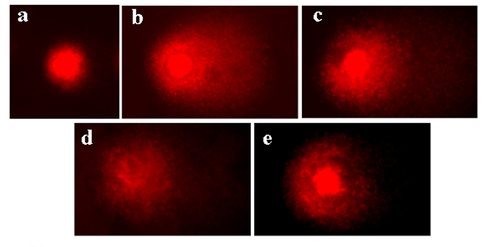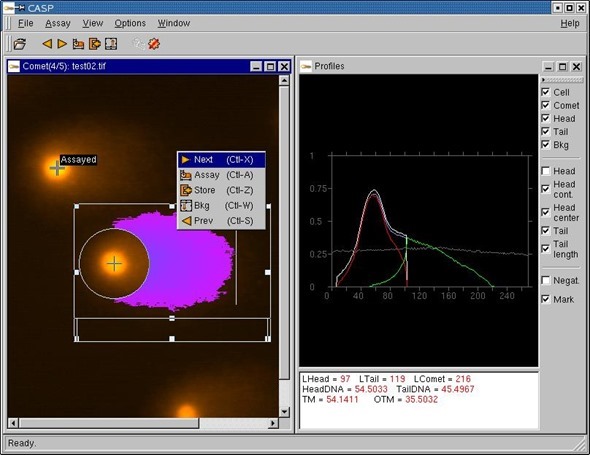The Comet Assay, also known as single cell gel electrophoresis (SCRE), helps scientists to determine whether there has been deoxyribonucleic acid (DNA) damage to a single cell from apoptosis (cell death) or cytotoxicity (toxicity to cells) and the extent of this damage. The DNA of an organism encodes the genetic instructions which govern the structure and functions of the constituent cells.

DNA damage (tail intensity) detected by the Comet Assay, credit: Aviello et al. (2011) PLOS Journal
In this case, damage is defined as single or double-stranded breaks in the DNA – such damage can be caused by chemicals or UV radiation. The Comet Assay can be applied to both eukaryotic (cell with a membrane-bound nucleus with the DNA structured in chromosomes) and prokaryotic (a cell with neither a membrane-bound nucleus nor DNA structured in chromosomes) cells.
The Comet Assay is used in oncology to screen for genotoxicity (damage to genetic materials), gauge chemoprevention effectiveness, and determine the effectiveness of specific agents to halt progression to invasive cancer in the human body.
Principle of the Comet Assay
In the Comet Assay process, cell damage is determined by employing the theory that when a charge is applied to a cell, the amount of DNA that leaves the nucleus is an indication of the amount of DNA damage.
In the process, the single cells under investigation are placed in low melting point agarose which is a gel-like polysaccharide derived from seaweed. This is often carried out on a microscope slide where the cell membrane is broken down (lysed) with the use of a detergent and high salt. This helps the cells to form nucleoids with the tightly coiled DNA in the nuclear matrix.
The next stage is electrophoresis - a charge is applied to the cells by using an electrical field. The damaged DNA, which has a negative charge, starts to move out of the nucleus towards the positively charged anode. The undamaged DNA stays where it is.
As the damaged DNA travels through the agarose, it creates trails like comet tails – this is visualized with fluorescence microscopy. The intensity, brightness and length of the comet tail relative to the head indicate the number of DNA breaks.
The underlying principle is likely that DNA breakage leads to a loss of supercoiling and results in the freedom to migrate towards the anode.
Comet Assay formats
There are two kinds of Comet Assay. In a Neutral Comet Assay, the DNA is kept as double strands so that the assay is used to detect double-stranded breaks. In contrast, an alkaline Comet Assay is carried out at pH8 and a denaturing step is included so that both single and double-stranded breaks can be determined.
Comet definition
The comet definition is determined by working out the percentage of DNA in the tail, dividing this by the integrated tail intensity and multiplying this by 100. The figure achieved is then divided by the total tail integration cell intensity.

Credit: Koncak / commons.wikimedia.org
Materials
The life sciences materials used in the assay can be obtained from companies such as AMSBIO. DNA staining can be achieved in a couple of different ways such as with fluorescent dyes observed with a fluorescent microscope. In fluorescence microscopy, the scientists detect and study the energy released from a sample by irradiating it with a specific wavelength of light.
Alternatively, a silver stain can be used with a light microscope which is also good for looking at small objects that the eye would not ordinarily be able to see. Scientists can also include an additional stage of applying fluorescent staining prior to using the microscope in this method.
To ensure appropriate running of the assay, scientists will also use a control system. This allows them to standardise and compare experiments for the given equipment used.
References
- Scorecomets.com on Comet Assay: http://www.scorecomets.com/about-the-comet-assay/what-is-the-comet-assay
- Scorecoments.com on how a Comet Assay works: http://www.scorecomets.com/about-the-comet-assay/how-does-it-work
- US National Library of Medicine, National Institutes of Health: http://www.ncbi.nlm.nih.gov/pubmed/15004294
- AMSBIO on Comet Assay
- AMSBIO presentation on Comet Assay
Further Reading
Last Updated: Jan 1, 2023